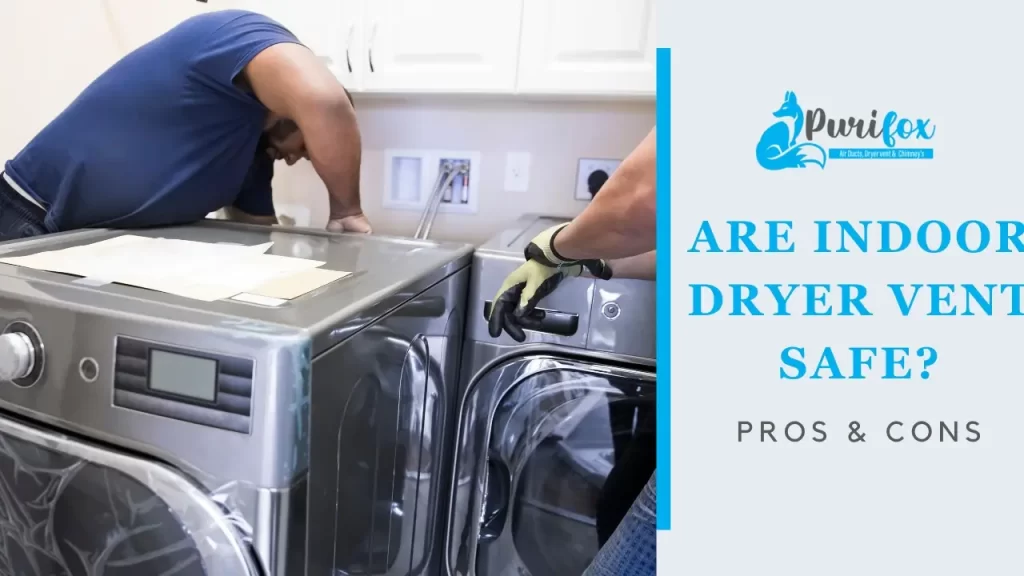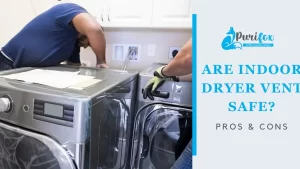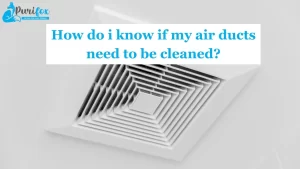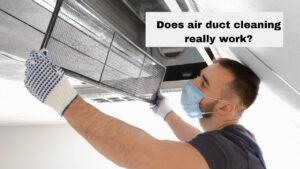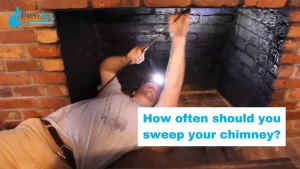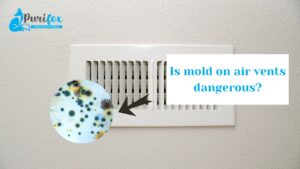The convenience of having a clothes dryer at our fingertips is undeniable. But what about that exhaust vent? Is it okay to leave it venting indoors, or should it always be directed outside? These are questions many homeowners grapple with, and the answer isn’t always clear-cut.
Indoor dryer vents have been a common practice for many years, but their safety has come into question. Is it really safe to vent your dryer indoors? What are the risks and benefits?
This blog post will explore the safety of indoor dryer vents and provide you with the information you need to make an informed decision about your own home.
What Are Indoor Dryer Vents?
An indoor dryer vent, unlike its traditional counterpart that exhausts outdoors, channels the hot air and moisture expelled by your clothes dryer into a designated space within your home. This interior space can be a laundry room, attic, or even a designated closet.
While outdoor vents remain the preferred and safer option for most dryers, indoor vents offer a practical solution in certain situations.
For instance, if your home lacks an external wall near the dryer location or if installing an outdoor vent would be structurally challenging, an indoor vent might be the only viable option.
Types of Indoor Dryer Vents:
Direct Vent: This option directly vents the air into a room, likely a laundry room or utility closet. While the simplest and most budget-friendly choice, it necessitates proper ventilation within the room to avoid moisture accumulation.
Condensing Vent: This type utilizes a condenser unit that extracts moisture from the air before releasing it back into the room. It offers better moisture control but requires a higher initial investment and regular maintenance.
Are indoor dryer vents safe?
While indoor dryer vents might seem like a convenient option, they are not the safest nor the healthiest choice for your home. For gas dryers, venting indoors poses a serious risk of carbon monoxide poisoning, as the gas produced by the dryer can build up and leak into your living space.
Even with electric dryers, indoor venting can lead to other problems, such as excessive moisture and dust build-up, creating a breeding ground for mold and negatively impacting your indoor air quality. Additionally, the accumulation of lint in the vent can become a fire hazard.
To avoid these potential dangers and ensure optimal dryer performance, it’s always best to vent your clothes dryer directly outside, regardless of its type. This will guarantee proper ventilation, prevent the buildup of harmful substances, and contribute to a healthier and safer living environment.
If venting outside is not feasible, consider alternative solutions like ventless dryers (electric only), dehumidifiers, or diligent vent cleaning and maintenance. Remember, prioritizing your safety and well-being should always be the top priority.
Indoor dryer vent pros and cons
Indoor dryer vents offer a convenient alternative to traditional outdoor vents, but they come with their own set of advantages and disadvantages. Here’s a breakdown of the key points to consider:
Pros of indoor dryer vent:
Easy Installation
Indoor dryer vents are much easier to install than traditional outdoor vents. They typically require no drilling or cutting through walls, making them a good option for renters or DIY enthusiasts.
Lower Installation Cost
Indoor dryer vents are generally cheaper to install than outdoor vents. This is because they require less equipment and labor. Additionally, you may not need to drill a hole through your wall to install an indoor vent. This can be a significant savings, especially if you are on a budget.
More Convenient
Indoor dryer vents can be installed anywhere in your home, regardless of whether there is an outside wall nearby. This can be helpful if you have limited space or if you don’t want to deal with running a vent hose through an outside wall.
Increased Heat Production
Indoor dryer vents release the heat generated by the dryer into your home, which can help to warm your living space in the winter. This can potentially lead to lower heating bills.
No Cold Drafts
Unlike outdoor vents, indoor dryer vents do not allow cold air drafts to enter your home. This can be especially beneficial in colder climates.
More Flexibility
Indoor dryer vents offer more flexibility in terms of dryer placement. You are not limited to placing your dryer near an exterior wall, which can be helpful in smaller homes or apartments.
Cons of Indoor Dryer Vents:
Air Quality Concerns
Indoor vents release moisture and lint into the air, potentially leading to decreased indoor air quality. This may be problematic for individuals with respiratory issues.
Fire Hazard
Lint build-up in the dryer vent is a fire hazard. Indoor dryer vents require more frequent cleaning and maintenance than outdoor vents to prevent lint buildup and potential fires.
Pollutants
Dryer exhaust contains a number of pollutants, including carbon monoxide and formaldehyde. Venting a gas dryer indoors can be dangerous, even with proper ventilation. Electric dryers are generally considered safer for indoor venting, but it’s still important to ensure proper ventilation and regular maintenance.
Increased Risk of Mold and Mildew
Indoor dryer vents can lead to an increase in mold and mildew growth in your home. This is because the moisture from the dryer is released into the air, where it can condense on surfaces and create a breeding ground for mold and mildew.
Increased Humidity
Indoor dryer vents vent the moisture from your clothes into your home, which can significantly increase the humidity levels. This can lead to a variety of problems, including mold and mildew growth, damage to your home’s structure, and respiratory problems for some individuals.
Reduced Efficiency
Indoor dryer vents can be less efficient than outdoor vents, which can lead to longer drying times. This is because the warm, humid air from the dryer is not being expelled from the house as quickly.
Not Suitable for All Climates
Indoor dryer vents are not ideal for humid climates, as the added moisture can exacerbate existing moisture problems. They are generally better suited for dry climates where the extra humidity can be beneficial.
Not Suitable for Gas Dryers
It’s important to understand that there are two different types of dryers: electric and gas. Electric dryers do not produce carbon monoxide, so they can be safely vented indoors with the proper precautions.
However, gas dryers must be vented outdoors. Venting a gas dryer indoors is extremely dangerous, as it can lead to carbon monoxide poisoning.
Are Indoor Dryer Vents Legal?
The legality of indoor dryer vents varies depending on your location. In most states and regions, indoor dryer vents are not permitted due to safety concerns.
Building codes often require dryers to vent directly outside to prevent the potential dangers associated with indoor venting, such as carbon monoxide poisoning, mold growth, and fire hazards.
While indoor dryer vent kits might exist, their use is generally prohibited by local regulations. They may be considered temporary solutions in specific situations, but never the recommended long-term option.
Always confirm the specific regulations in your area before considering any indoor dryer venting solution. You can consult your local building department or a qualified electrician for accurate legal information and safe installation practices.
Remember, prioritizing your safety and complying with local regulations is crucial. Opt for venting your dryer directly outside whenever possible, and explore alternative solutions like condenser dryers or dehumidifiers if external venting isn’t feasible.
Some Safety Tips for Indoor Dryer Vents
While indoor dryer vents are generally not recommended due to safety hazards, there are some precautions you can take if you absolutely must use one:
1. Only use with electric dryers: NEVER use an indoor dryer vent with a gas dryer. Gas dryers produce carbon monoxide, which is a deadly gas and can be fatal if it leaks into your home.
2. Clean the lint trap regularly: This is essential to prevent lint buildup in the vent, which can become a fire hazard. Clean the lint trap after every drying cycle.
3. Clean the vent hose and vent hood: This should be done at least once a year by a professional dryer vent cleaning service.
4. Install a carbon monoxide detector: This will help to alert you if there is a leak of carbon monoxide in your home.
5. Ensure adequate ventilation: Open windows in the laundry room while the dryer is running.
6. Keep the vent hose short and straight: Long and/or kinked vent hoses can restrict airflow and increase the risk of fire.
7. Use a vent hood with a backdraft damper: This will help to prevent lint from being blown back into the house.
8. Never use foil or plastic to vent your dryer: These materials can melt and create a fire hazard.
9. Have your dryer inspected regularly: This will help to ensure that the dryer is functioning properly and that there are no safety hazards.
10. Consider alternative solutions: If possible, consider installing an outdoor vent or using a ventless dryer.
Remember, even with these precautions, indoor dryer vents are not as safe as outdoor vents. If you are concerned about the safety of your indoor dryer vent, it is best to consult with a qualified dryer vent cleaning service or a professional electrician.
Schedule your Dryer Vent Cleaning Today With Purifox
Don’t let a clogged dryer vent put your safety and wallet at risk. Purifox, a trusted provider in Virginia, Maryland, and Washington D.C., offers comprehensive dryer vent inspection and cleaning services for just $89. Our expert technicians will remove lint and debris, improving safety, reducing energy costs, and ensuring your dryer runs efficiently.
Schedule your appointment today and experience faster drying times, extended dryer life, and improved air quality. Visit our website or call (571) 244-2603 to book your service and enjoy the peace of mind that comes with a clean dryer vent.
FAQs
Can you vent a dryer into a crawl space?
Venting your dryer into a crawl space poses several serious risks and is strongly discouraged. It significantly increases the chance of fire due to lint accumulation and allows harmful carbon monoxide (from gas dryers) to leak into your living space.
Do electric dryers need to be vented outside?
Yes, it is highly recommended to vent electric dryers outside. While some electric dryers advertise themselves as “ventless,” they still require some form of moisture removal, which can be inconvenient and less efficient than traditional outdoor venting.



